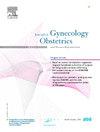What are the risk factors for severe neonatal acidosis in labor at term? A single-center retrospective case-control study
IF 1.6
4区 医学
Q3 OBSTETRICS & GYNECOLOGY
Journal of gynecology obstetrics and human reproduction
Pub Date : 2025-07-25
DOI:10.1016/j.jogoh.2025.103001
引用次数: 0
Abstract
Objective
The aim was to determine the risk factors associated with severe acidosis during labor in newborns at term.
Methods
This was a retrospective monocentric case-control study, from January 2018 to December 2020. Cases included were all births with pH <7.0 at birth, single pregnancy, >37 weeks, without severe fetal malformation, and with an attempted vaginal delivery. For each included case, two controls were selected. These were the two deliveries immediately preceding the case, with pH >7.0 and no exclusion criteria. The two groups were compared as pairs, followed by a multivariate analysis of factors associated with the occurrence of severe acidosis.
Results
Eighty-seven cases of severe acidosis were compared with 174 controls. After multivariate analysis, factors associated with the occurrence of acidosis were induction (odds ratio (OR) 2.41, confidence interval (CI) 95 %, 1.10–5.26), meconium fluid during labor (OR 4.38, CI 95 %, 1.14–16.78), the presence of uterine hyperstimulation (OR 3.15, CI 95 %, 1.45–6.83), and the occurrence of a sentinel event (shoulder dystocia, cord prolaps, uterine rupture) with OR 11.74, CI 95 %, 2.93–46.97. Conversely, increasing gestational age at delivery in weeks was found to be a protective factor (OR 0.33, CI 95 %, 0.24–0.46).
Conclusion
Several factors have been identified as being associated with the occurrence of acidosis. Their presence should alert the on-call team. The main factor, however, was the occurrence of a sentinel event, which is difficult to predict.
足月分娩时新生儿严重酸中毒的危险因素有哪些?单中心回顾性病例对照研究
目的探讨足月新生儿产程严重酸中毒的相关危险因素。方法2018年1月至2020年12月为回顾性单中心病例对照研究。纳入的病例均为出生时pH 7.0,单胎妊娠,37周,无严重胎儿畸形,并尝试阴道分娩。对于每个纳入的病例,选择两个对照。这是病例发生前的两次分娩,pH >7.0,没有排除标准。将两组患者作为一对进行比较,然后对发生严重酸中毒的相关因素进行多变量分析。结果重度酸中毒患者87例,对照组174例。多因素分析后,与酸中毒发生相关的因素有诱导(优势比(OR) 2.41,可信区间(CI) 95%, 1.10-5.26)、分娩时胎液(OR 4.38, CI 95%, 1.14-16.78)、子宫过度刺激(OR 3.15, CI 95%, 1.45-6.83)和前哨事件(肩难产、脐带脱出、子宫破裂)的发生(OR 11.74, CI 95%, 2.93-46.97)。相反,增加周分娩胎龄被发现是一个保护因素(OR 0.33, CI 95%, 0.24-0.46)。结论多种因素与酸中毒的发生有关。他们的出现应该会引起待命小组的注意。然而,主要因素是哨兵事件的发生,这是难以预测的。
本文章由计算机程序翻译,如有差异,请以英文原文为准。
求助全文
约1分钟内获得全文
求助全文
来源期刊

Journal of gynecology obstetrics and human reproduction
Medicine-Obstetrics and Gynecology
CiteScore
3.70
自引率
5.30%
发文量
210
审稿时长
31 days
期刊介绍:
Formerly known as Journal de Gynécologie Obstétrique et Biologie de la Reproduction, Journal of Gynecology Obstetrics and Human Reproduction is the official Academic publication of the French College of Obstetricians and Gynecologists (Collège National des Gynécologues et Obstétriciens Français / CNGOF).
J Gynecol Obstet Hum Reprod publishes monthly, in English, research papers and techniques in the fields of Gynecology, Obstetrics, Neonatology and Human Reproduction: (guest) editorials, original articles, reviews, updates, technical notes, case reports, letters to the editor and guidelines.
Original works include clinical or laboratory investigations and clinical or equipment reports. Reviews include narrative reviews, systematic reviews and meta-analyses.
 求助内容:
求助内容: 应助结果提醒方式:
应助结果提醒方式:


